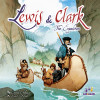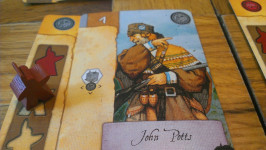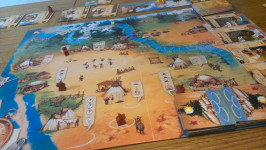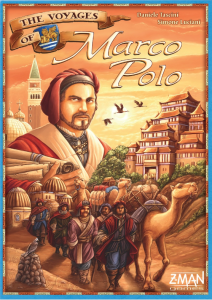- Learning time
- 40 minutes
- First play time
- 150 minutes
Lewis & Clark
Designed by: Cédrick Chaboussit
Lewis and Clark is inspired by the trail-blazing adventurers familiar to most Americans: 200 years ago they made their way across Louisiana to the Pacific. And now you play adventurers attempting the same journey.
Essentially then, it’s a race. Everybody starts with their adventurers and base camp on the Mississippi River and heads west; first to reach the ocean wins. How you race is by using a series of cards to push your adventurer forwards, before – at chosen moments – making camp, at which point your base camp catches up with the adventurer.
You begin with a set of cards, and each card represents a historical figure from the Lewis and Clark era. Each figure can perform different actions, and on your turn you play a card and choose which action to activate: generally speaking, you want to be moving in a race game, but there are other options available on the board that give some extra variety and flavour around the card-playing. You can gather goods that can be used later in a number of ways; there’s wood to build with, buffalo to eat and hides that you can use to buy more cards and improve your hand. You can also recruit Native Americans to your party, who can go out and get you more goods from the country around the river.
But you can only store a limited number of resources and people, depending on how many boats you have (you’re traveling along a river, remember) – and the more resources a boat carries, the slower it goes!
But the crux of the game is that the card is ‘powered’ by sacrificing other cards from your hand, which means they’re no longer available until you choose to make camp. When you make camp two things happen: the good is that all your spent cards return to your hand, and your base camp catches up with the guy who’s rushing ahead, making the pace. The bad is that before your camp catches up with you, any cards left in your hand and any resources in your boats drag your adventurer back a number of spaces. So you’re kind of managing all this stuff that’s helpful on your journey, with the fact it weighs you down. And on a crowded river where you’re not permitted to stop in the same spot as another player, the moving back and forth can potentially catapult you into the lead, or send you to lowly last place.
As the game progresses, you can not only buy more cards (using hides, as mentioned above, plus some goods) but you can also chuck cards away and get some goods in return. You’ll realize as you play that some cards are much more powerful than others and really worth having – but they still need to be powered by other cards, so don’t chuck them away willy-nilly (as Lewis used to say).
As soon as somebody gets their base camp to the Pacific Ocean the current round is played to the end, and the winner is the closest to the ocean.
Joe says
Not played - like the artwork though.
The guru's verdict
-
Take That!
Take That!
There's not a huge amount of Take That. Clever players may see opportunities to make their camps in places to spoil your plans though.
-
Fidget Factor!
Fidget Factor!
Moderate to high. Because of how Lewis and Clark plays, you can't be 100% sure what you'll do until your turn arrives. With everyone around the table going through the same experience, there will be some down-time.
-
Brain Burn!
Brain Burn!
Although the board is friendly and the theme is interesting, the actual play involves some analysis of how best to use your cards, which cards to sacrifice in order to power others, when to move camp and so on.
-
Again Again!
Again Again!
If you like Lewis and Clark, the way the cards work (it's more a card game than a board game) ensure there's a huge variety.













Sam says
I'm all for a challenge and making disparate elements of the same game function as an 'engine' appeals to me in many ways. Designer Stefan Feld makes games I like that are rather puzzley in this aspect. With Lewis and Clark though, I felt there were just too many permutations, and because of how the game plays there are potentially long breaks while you wait for your turn - during which time you can't really plan anything, as the parameters of what you can achieve when your go finally arrives are constantly shifting. So while I can respect the game as a clever design (the mechanics are neat and it really does feel like a race, albeit a rather staccato one) it doesn't really do it for me. If you like a real head-scratcher, however...